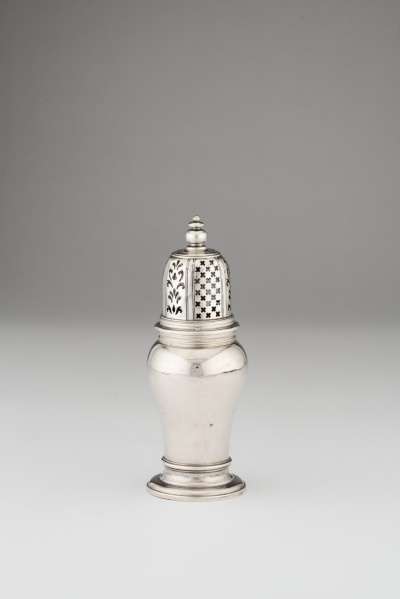Sugar caster
In the 1500s sugar was only available to very rich people. Sugar cane was grown in Mediterranean countries and the islands off West Africa, where enslaved Africans were used as labour. When Europeans began new plantations in the Americas and Caribbean they continued to use enslaved people and were able to produce much more sugar. This meant the cost went down, and by the 1600s ordinary people were enjoying sweet treats.
After 1700, sugar was in great demand as a sweetener for the new, fashionable drinks of tea and coffee. Booming sales and the use of slave labour allowed some sugar planters to become very rich and powerful. Plantation owners who returned to Britain could afford grand homes and promoted their commercial interests in Parliament.
Sugar was commonly sold in large blocks known as sugar loaves. But it could also be ground finely enough to be ‘cast’ over drinks and foodstuffs. Only the wealthy could afford this. These sugar casters show that some Exeter people had become very rich by the early 1700s.
After 1700, sugar was in great demand as a sweetener for the new, fashionable drinks of tea and coffee. Booming sales and the use of slave labour allowed some sugar planters to become very rich and powerful. Plantation owners who returned to Britain could afford grand homes and promoted their commercial interests in Parliament.
Sugar was commonly sold in large blocks known as sugar loaves. But it could also be ground finely enough to be ‘cast’ over drinks and foodstuffs. Only the wealthy could afford this. These sugar casters show that some Exeter people had become very rich by the early 1700s.
Object Summary
- Accession Loan No.
- 19/1954
- Category
- Decorative Art
- Collection Class
- Silver
- Material
- silver
- Common Name
- sugar caster
- Simple Name
- Sugar caster
- Inscription Transcription
- I / W / A
- Period Classification
- George II (1727-1760)
- Production Town
- Falmouth
- Production County
- Cornwall
- Production Country
- United Kingdom: England
- Production Person Initials
- Micon
- Production Person Surname
- Melun
- Production Year Low
- 1733
- Production Year High
- 1734


